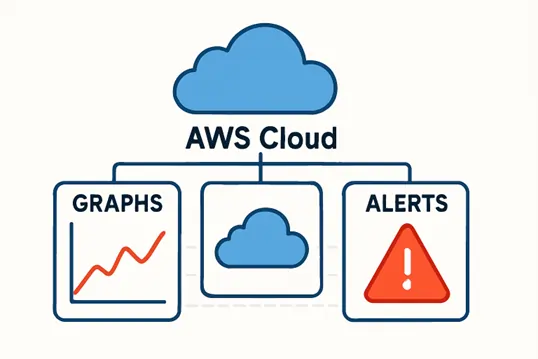Modern organizations are rapidly embracing cloud platforms to drive efficiency, agility, and cost savings in their operations. However, with these remarkable benefits come nuanced challenges that stem from the dynamics of shared infrastructure, on-demand scalability, and global access. The resultant systems and architectures are often highly distributed and complex, featuring a myriad of interconnections, third-party integrations, and evolving security considerations. In this rapidly shifting environment, proficient monitoring becomes a foundational pillar of effective cloud management. That’s why AWS monitoring is indispensable, offering both a granular view of workloads and high-level oversight for cloud-hosted environments. Such visibility ensures teams can quickly address anomalies, optimize resources, and make informed decisions with confidence.
As organizational workloads scale and underlying architectures trend toward microservices, containers, and hybrid setups, the challenge of maintaining optimal and secure operations becomes multifaceted. Teams are faced not only with preventing downtime but also with upholding consistent performance, reinforcing compliance, and proactively managing costs. Rising complexity means that small misconfigurations or visibility gaps can have major repercussions. Thus, it’s crucial to deploy sophisticated monitoring strategies and automation-driven tools that provide real-time insights and proactive alerts. By internalizing the core principles of streamlined cloud management, IT leaders can leverage complexity as a source of competitive differentiation and operational efficiency. This shift transforms cloud challenges into opportunities for innovation, allowing staff to focus on value-added tasks rather than firefighting.
AWS distinguishes itself as a market leader by providing an extensive array of robust tools created specifically to tackle the unique demands of today’s cloud landscapes. With these, organizations gain the means to prevent service interruptions before they impact business operations. In addition, effective monitoring aids in financial management by highlighting resource waste and underutilization, ensuring security policies are always enforced, and continuously benchmarking and optimizing application performance. To remain at the forefront of reliability and business agility, teams must stay current with AWS advancements and industry best practices, which serve as critical guides for modern cloud management.
Cloud experts universally recommend keeping an eye on emerging monitoring strategies and continually exploring advancements in observability. Many organizations leverage insights from respected sources which provide practical recommendations for addressing evolving threats and streamlining operations. Adopting a learning mindset empowers IT leaders to build resilient and future-ready cloud operations.
Understanding Cloud Complexity
The journey to the cloud holds the promise of unprecedented agility, uncertainty-busting scalability, and meaningful cost reductions. Yet, while the upside is significant, organizations quickly find themselves navigating a maze of operational intricacies. These can include distributed systems infrastructure, intricate microservices architectures, containerized applications, and the simultaneous management of resources across multiple clouds. The proliferation of third-party integrations and API-connected services further complicates the landscape. This complexity generates new classes of operational headaches—for example, teams may experience unpredictable performance swings, encounter shadow IT, discover security vulnerabilities after the fact, or find that the velocity of change outpaces their governance controls.
Neglecting these operational challenges can lead to serious issues, ranging from regulatory compliance failures to costly service disruptions or even data breaches. Proactive and precise monitoring is a crucial countermeasure, equipping IT teams with the actionable insights they need to maintain availability and performance while addressing security vulnerabilities. With modern cloud systems, organizations can’t afford to wait for users to report issues. Instead, monitoring tools act as both sentinels and advisers—spotting subtle changes in traffic patterns, alerting teams to anomalous resource consumption, and ensuring that even the most complex, mission-critical workloads remain protected and resilient.
AWS Tools for Effective Monitoring
To tame the inherent complexity of public and hybrid clouds, AWS provides a suite of purpose-built monitoring solutions that cover every aspect of the technology stack. These tools are engineered for visibility, automation, and seamless management of vast environments, whether fully native to AWS or spanning on-premises and cloud resources. The foundational capabilities include:
- Amazon CloudWatch: Serving as the nerve center for observability in AWS, CloudWatch aggregates and presents real-time analysis of logs, performance metrics, and infrastructure events. Teams rely on customizable dashboards, automated alarms, and in-depth visualizations to spot trends, pinpoint resource inefficiencies, and tailor auto-scaling policies. CloudWatch’s flexibility means you can extend monitoring capabilities to application-level logs, synthetic transactions, and even custom business metrics.
- AWS CloudTrail: Another core component, CloudTrail ensures complete audibility by capturing and recording every API call and account activity across your cloud estate. This is indispensable for security audits, advanced troubleshooting, and meeting strict compliance mandates regarding access and change management. Teams use CloudTrail logs to reconstruct events, respond to suspicious activity, and enforce least-privilege policies.
- AWS Config: AWS Config continuously monitors and evaluates the configuration state of all resources, flagging deviations or unauthorized changes. It creates a comprehensive audit trail that supports both governance and remediation—helping administrators quickly roll back unintended modifications and assess compliance posture.
When integrated, these solutions create a comprehensive monitoring framework, significantly reducing manual oversight while enhancing transparency. Organizations leveraging AWS’s monitoring backbone can confidently administer complex deployments and foster a culture of accountability and agility, knowing that every layer—from infrastructure to applications—is under watchful observation.
Recent Innovations in AWS Monitoring
AWS continually innovates to empower businesses with the latest tools needed for cutting-edge observability. Over the past year, several new features have been released that directly address monitoring challenges related to cost, usability, and data analysis at scale. These advancements are game-changers:
- Amazon CloudWatch Logs Infrequent Access (Logs IA): Organizations managing vast amounts of log data often struggle with high storage costs and regulatory requirements regarding retention. With the new Logs IA storage class, it is now possible to retain massive amounts of logs for months or years at a fraction of the traditional price. This enables organizations to conduct deep forensic analysis and satisfy compliance mandates, all while maintaining budget control.
- Natural Language Query Generation: By applying generative AI technology, AWS enables staff to extract insights from logs and metrics using simple, plain-language prompts. This feature significantly lowers the technical barrier to powerful data analysis, allowing non-technical users and business stakeholders to participate in cloud observability. Rapid access to meaningful insights accelerates troubleshooting and facilitates smarter decision-making.
These innovations reflect AWS’s dedication to reducing the friction and skill gap associated with deep cloud monitoring and observability practices. As cloud architectures continue to evolve, organizations equipped with sophisticated and cost-effective monitoring solutions will be well-positioned to adapt swiftly, maintain operational excellence, and consistently deliver better outcomes for their users.
Best Practices for Simplifying Cloud Management
Implementing automation in monitoring, response, and operational maintenance is essential for modern enterprises. Solutions such as CloudWatch Alarms and AWS Lambda help detect and automatically resolve issues, enhancing response times and minimizing human error. This automation allows IT teams to shift their focus from routine troubleshooting to innovation. Establishing a centralized monitoring strategy is vital; it consolidates log and metric collection across various accounts, services, and environments, significantly improving the organization’s ability to identify misconfigurations, security incidents, or underperformance. Centralized dashboards offer a comprehensive view of health and performance, providing stakeholders with clear and actionable insights. Regular configuration reviews and continuous auditing through AWS Config, along with scheduled architecture assessments, ensure that cloud resources are maintained in compliance with regulations, business goals, and best industry practices. These practices enable iterative improvements, helping organizations manage technical debt as they grow. By emphasizing visibility, control, and automation, organizations can fully leverage the benefits of AWS cloud environments.
Conclusion
Effective monitoring is the cornerstone for conquering the growing complexity and risk inherent in cloud deployments. By embracing AWS’s innovative toolset, integrating emerging technologies, and supporting their teams with proven strategies, organizations can safeguard mission-critical applications, optimize resource investments, and maintain robust security and compliance postures. Continuous learning and adaptation will ensure that IT teams keep pace with AWS’s capabilities and evolving best practices, empowering them to thrive in the era of cloud-first business.
Read more: The Best AI Talking Photo and AI Image Editor Tools of 2025 – Reptile Guided
How a Smart Digital Marketing Strategy Could Boost Business – Reptile Guided
Transforming Early-Stage UI Into Stunning Visual Concepts – Reptile Guided





